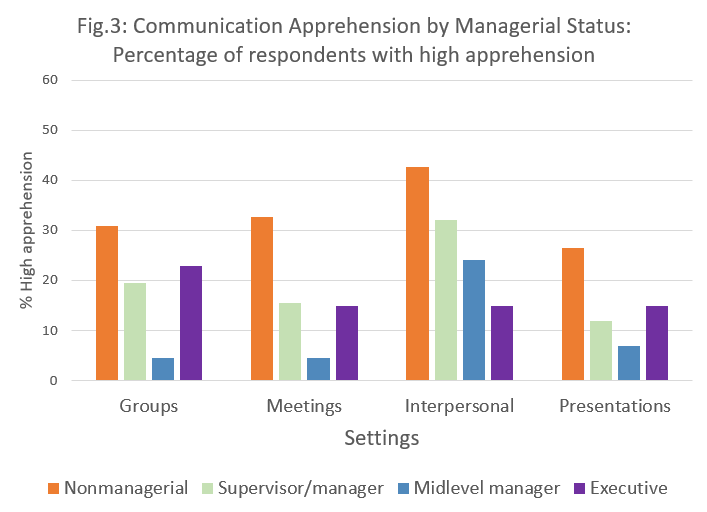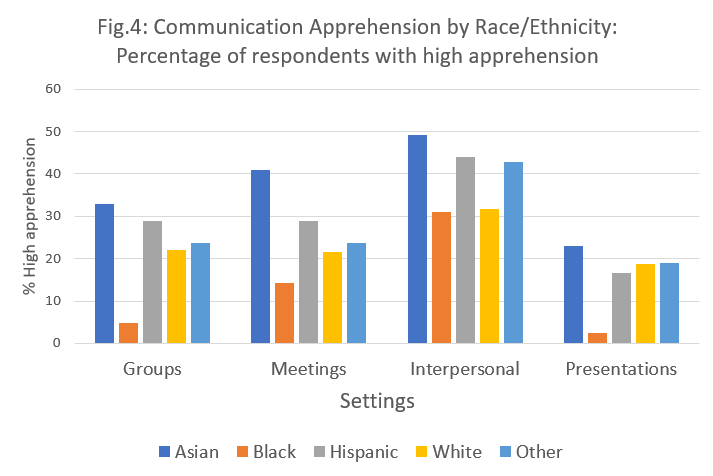
- Do you – or your employees / line reports – feel anxious or fearful about speaking at work?
- Are there some situations when it feels more difficult than others?
- Do factors like gender, age, managerial status, and/or race / ethnicity have an influence?
These are questions that Peter Cardon and colleagues[1] have recently researched. In this GPC Latest Research Insight, we report some of their key findings and consider the implications for an inclusive and innovative workplace.
Labelling the issue
Technically, fear of speaking is called ‘communication apprehension’. The concept is defined as “fear or anxiety associated with either real or anticipated communication with another person or persons.”
Why is the issue important?
Strong communication skills are highly valued in the workplace, and recruiters often want to see evidence of them in job interviews. Yet when people are anxious about speaking (i.e. when they have high communication apprehension), this can lower their chances of success in many different contexts – e.g. in job interviews, in selection for particular roles, and in their promotion prospects.
Moreover, communication apprehension can affect people’s sense of belonging and inclusion, and ultimately equity at work.
The study
Peter Cardon and colleagues wanted to explore communication apprehension in working adults. They used a standard psychological survey[2] to explore how nervous or relaxed people felt about speaking in four different contexts: in group discussions, in meetings, when conversing with a new acquaintance, and when giving a presentation. 793 working adults, living in the USA, completed the survey. The researchers then calculated the percentage of respondents showing low, moderate or high levels of communication anxiety, using benchmark criteria for the cut-off points. The bars in the charts below show the percentage of respondents reporting high levels of communication apprehension in each of the four communication settings; in other words, the charts show the proportion of respondents reporting high levels of fear or anxiety about speaking in these different contexts.
The researchers also collected some background information on the respondents, so that they could compare levels of communication apprehension across different personal characteristics, including age, gender, managerial status, and race / ethnicity.
What did they find?
Here we report the findings from the study. We comment on them further below.
The Impact of gender
Figure 1 shows:
- A larger proportion of women than men reported high levels of anxiety in speaking in all four contexts, with it being particularly noticeable in meetings and when giving presentations.
- For both men and women, interpersonal settings were the most anxiety-inducing. (In the survey, this referred to situations involving two people conversing with each other, especially when they were new acquaintances.) Approximately one third of both male and female respondents reported feeling high levels of anxiety in this setting.

The Impact of age
Figure 2 shows:
- The younger the age of the respondents, the larger the proportion reporting high levels of anxiety. This was true for all contexts.
- Respondents of all ages reported lower levels of anxiety when giving presentations than for other settings.
- For most of the age groups, and especially the two younger groups (18-29, 30-44), interpersonal settings were particularly anxiety inducing. For the youngest group, 54.5% of respondents reported high levels of communication apprehension, and for the next youngest group (30-44), it was 40%. This is a noticeable proportion.

The Impact of managerial status
Figure 3 shows:
- Respondents in nonmanagerial positions reported higher levels of communication anxiety than those in higher positions.
- For all except executives, interpersonal settings were the most anxiety-inducing.
- For executives, group discussion settings were more anxiety-inducing than other settings. 22.8% of respondents – almost one quarter – reported high levels of communication apprehension in these contexts.
- Only a very small proportion of mid-level managers (4.6% – 6.9%) reported communication anxiety in group discussions, meetings or when giving a presentation. However, in interpersonal settings, this proportion increased to 24.1% (i.e. almost one quarter).

The Impact of race / ethnicity
Figure 4 shows:
- Asian, Hispanic and ‘Other’[3] respondents reported higher levels of communication anxiety in all settings, compared with Black and White respondents.
- For respondents of all racial/ethnic groups, interpersonal settings were the most anxiety-inducing. This was particularly noticeable for Asian, Hispanic and ‘Other’ respondents.
- Giving presentations was the least anxiety-inducing setting for all racial / ethnic groups.

Summary of findings
- All of the personal characteristics reported here (gender, age, managerial status, and race / ethnicity)[4] affected the level of communication apprehension that employees felt.
- Women, younger employees, employees of lower status, and employees from Asian, Hispanic and ‘Other’ racial / ethnic backgrounds experienced higher levels of communication anxiety than other employees.
- All respondents, irrespective of personal characteristics, reported higher levels of anxiety for interpersonal settings than for other settings. This was usually more pronounced for women, younger employees, employees of lower status, and those from Asian, Hispanic and ‘Other’ racial / ethnic backgrounds.
- All respondents, irrespective of almost all personal characteristics, reported lower levels of anxiety when giving a presentation than for other settings.
Key takeaways
The study was carried out exclusively in the USA and so more research is needed to explore employees’ levels of communication apprehension in other countries and contexts. Nevertheless, its findings fit in with the experiences of many coaches and consultants in different parts of the world.[5] The study draws attention to two main issues: (a) inclusion and equal opportunities and (b) rapport.
Inclusion and equal opportunities
The study showed:
- Women, younger employees, employees of lower status, and employees from Asian, Hispanic and ‘Other’ racial / ethnic backgrounds may experience more inclusion difficulties than other employees because of differences in communication apprehension;
- There may be unequal opportunities in the workplace for women, younger employees, employees of lower status, and employees from Asian, Hispanic and ‘Other’ racial / ethnic backgrounds because of differences in communication apprehension;
- Creativity and innovation may be hampered by failure to draw on the ideas and suggestions of all members of the workforce, because of communication apprehension by certain members.
- Whatever the level of communication apprehension, even if it affects only a minority, it is nevertheless extremely important to address it. This involves understanding the underlying reasons for it and then finding ways of reducing it.
Global fitness in communicating
If you would like to learn more about communication apprehension, including the factors that affect it and ways of overcoming it, get in touch with us. We offer a range of services to support you in this. Just email GPC or Helen directly.
Also, our latest book Global Fitness for Global People: How to manage and leverage cultural diversity at work provides many insights.
The need for rapport
The study also revealed that the most anxiety-inducing situation for all respondents, irrespective of their personal characteristics, was holding social conversations, especially with new acquaintances. Much business success depends on employees forming positive relationships with colleagues and clients, whatever their backgrounds, so this is a second area to attend to.
Global fitness in building and managing rapport
Our internationally renowned rapport management model offers valuable insights and we offer a range of services and resources to help you in this.
So if you would like to learn more about rapport building and relationship management, and to find ways of enhancing it, get in touch with us. Just email GPC or Helen directly.
Also, our latest book Global Fitness for Global People: How to manage and leverage cultural diversity at work provides many more insights, including several chapters specifically devoted to this.
Professor Helen Spencer-Oatey, Managing Director
References / Notes
[1] Cardon, P., Okoro, E. A., Priest, R., & Patton, G. (2022). Communication apprehension in the workplace: Focusing on inclusion. Business and Professional Communication Quarterly, Online first, https://doi.org/10.1177/23294906221129599.
[2] Personal Report of Communication Apprehension-24 (PRCA-24)
[3] ‘Other’ included Native American, Alaskan Native, Multiracial, Biracial, not listed here, prefer not to say.
[4] The study also examined employment status (full-time or part-time) and mental illness (levels of anxiety and depression), but for reasons of space they are not reported here. Please see the original study for more details on these features.
[5] E.g. See Helen Frewin’s book Better than Confidence.

